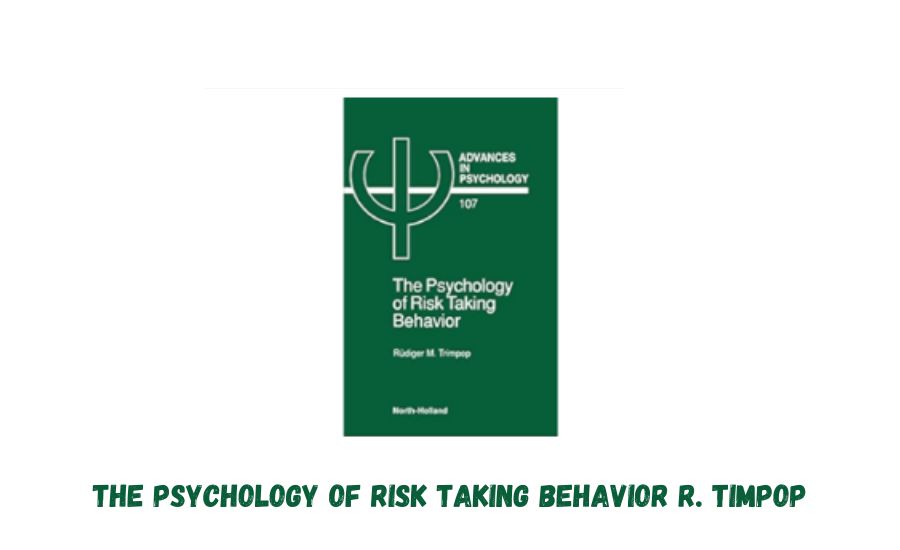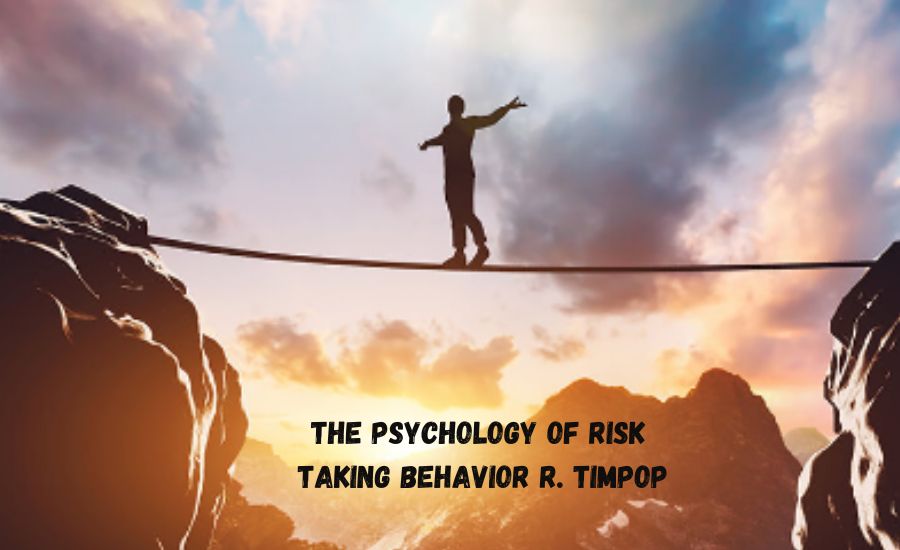Discover The Psychology of Risk Taking Behavior R. Timpop: Why Do We Take Risks?

What Is the Psychology of Risk Taking Behavior R. Timpop?
Risk-taking is something we all do, whether it’s big or small. The psychology of risk taking behavior R. Timpop focuses on why people choose to take these risks. Some people take risks for fun, while others might do it for a reward.
R. Timpop’s research helps us understand what goes on in the brain when we make risky decisions. This helps explain why some people enjoy things like extreme sports or starting a new business. Understanding this behavior is key to knowing why we make certain choices.
In simple terms, the psychology of risk taking behavior R. Timpop shows that everyone views risks differently. For some, risk means excitement, while for others, it’s something to avoid. It’s all about how we weigh the possible outcomes.
Whether it’s crossing the road without looking or making a big financial investment, risks are part of life. By understanding how and why we take risks, we can make better choices in the future.
Why Do People Love Taking Risks? Insights from R. Timpop
Many people love the thrill of taking risks. R. Timpop explains that this love for risks comes from how our brain works. When we take risks, our brain releases chemicals that make us feel excited and happy. This is why some people keep seeking new and daring experiences.
R. Timpop also shares that people who take risks may enjoy the sense of control they feel. When they face a challenge, they feel powerful when they overcome it. This can be as simple as playing a challenging game or climbing a mountain.
Some people love risks because they don’t like routine. They get bored easily, so they look for ways to add excitement to their lives. The psychology of risk taking behavior R. Timpop shows that this need for excitement is common among thrill-seekers.
In the end, it’s the feeling of achievement and excitement that makes risk-taking so appealing. People love the reward that comes from facing something unknown and succeeding.
How the Brain Responds to Risky Behavior: R. Timpop’s Findings

When we take a risk, our brain reacts in fascinating ways. According to R. Timpop, when faced with a risky decision, our brain has to quickly decide if the reward is worth the risk. It uses past experiences and feelings to make this choice.
One part of the brain that plays a big role in risk-taking is called the amygdala. The amygdala is responsible for processing emotions like fear and excitement. This helps explain why some risks make us feel scared, while others feel thrilling.
The psychology of risk taking behavior R. Timpop shows that different people’s brains react differently to the same risks. For some, the brain might focus on the danger, while others might focus on the potential reward.
Understanding how our brain processes risk helps us see why some people are natural risk-takers, while others prefer to play it safe. By studying this, we can learn how to manage risk better.
The Role of Fear in Risk Taking Behavior: Lessons from R. Timpop
Fear is a natural part of risk-taking. R. Timpop explains that fear helps keep us safe by warning us when something might be dangerous. However, some people ignore their fear and still take risks. This is because they weigh the reward as being worth more than the fear.
The psychology of risk taking behavior R. Timpop shows that fear can sometimes stop us from doing things we might enjoy or benefit from. For example, someone might avoid starting a business because they are afraid of failure.
At the same time, fear can also help us make smart decisions. It can protect us from harm by telling us when a risk is too big. R. Timpop suggests that finding a balance between fear and courage is key to healthy risk-taking.
So, while fear is a part of risk, it doesn’t always have to stop us. The goal is to learn how to manage fear, so we don’t miss out on opportunities.
Why Some People Take More Risks Than Others: R. Timpop Explains
Not everyone likes taking risks. Some people take more risks than others, and R. Timpop explains that this comes down to personality and experiences. People who are naturally adventurous or confident are more likely to take risks.
The psychology of risk taking behavior R. Timpop also shows that past experiences can shape how we see risk. If someone has had success with risks before, they might feel more comfortable taking more in the future. On the other hand, if someone has faced failure, they might avoid risk altogether.
It’s also important to know that some people have a higher tolerance for uncertainty. They don’t mind the unknown, while others find it uncomfortable. This difference in how people view uncertainty plays a big role in risk-taking behavior.
In short, people’s personalities and past experiences heavily influence how they take risks. Knowing this can help us understand why some people are more willing to take chances than others.
How Age Affects Risk Taking: R. Timpop’s Research
As we grow older, our attitude towards risk changes. R. Timpop’s research shows that younger people are more likely to take risks because they are still learning about the world. Their brains are wired to explore and try new things.
The psychology of risk taking behavior R. Timpop also reveals that as we age, we become more cautious. This is because we have more life experiences and understand the consequences of risky behavior. Older people might think twice before taking the same risks they did when they were younger.
One reason for this change is that older people may have more responsibilities, such as family or work. These responsibilities make them more careful in their decisions.
Overall, age has a strong influence on risk-taking. Younger people take more risks because they are more open to new experiences, while older people tend to play it safe.
The Link Between Personality and Risk Taking Behavior: R. Timpop Explores

Our personality plays a big role in how we handle risk. Some people are naturally more adventurous, while others prefer stability. R. Timpop’s work shows that personality traits like confidence and curiosity often lead to more risk-taking.
The psychology of risk taking behavior R. Timpop suggests that people who are more outgoing and open to new experiences are more likely to take risks. They enjoy the thrill and challenge of trying something new.
On the other hand, people who are more cautious and like routine tend to avoid risks. They prefer things they can control and predict.
Personality is just one piece of the puzzle, but it’s a big factor in understanding why some people take more risks than others. By knowing our own personality, we can better understand our comfort level with risk.
How Emotions Influence Risk Taking: R. Timpop’s Thoughts
Emotions play a powerful role in risk-taking. According to R. Timpop, feelings like excitement, anger, or even sadness can push us to take risks we wouldn’t normally consider.
When people are feeling excited or happy, they are more likely to take a chance. They feel more confident and are willing to face the unknown. On the flip side, when someone is sad or stressed, they might take risks to escape their emotions.
The psychology of risk taking behavior R. Timpop also highlights how emotions can cloud judgment. If we are too caught up in our feelings, we might overlook the potential dangers of a risk.
By understanding how emotions impact risk, we can make more thoughtful decisions. Managing our feelings helps us take smarter risks.
The Psychology Behind Thrill-Seeking: R. Timpop’s Views
Thrill-seekers are people who love chasing adrenaline. R. Timpop explains that these people often take extreme risks because it makes them feel alive. From skydiving to bungee jumping, thrill-seekers enjoy the excitement that comes with danger.
The psychology of risk taking behavior R. Timpop shows that thrill-seekers have a high tolerance for fear and uncertainty. They see risk as something fun and exciting, not something to avoid.
For thrill-seekers, the rush of adrenaline is the reward they get from taking risks. This feeling can be addictive, leading them to seek out more and more thrilling experiences.
In the end, thrill-seeking is all about enjoying the ride, even if it comes with risks. These people love the challenge of pushing their limits.
Risk Taking in Everyday Life: R. Timpop’s Insights
We encounter risks every day, from deciding what to eat to choosing a job. R. Timpop’s insights help us understand how these everyday decisions involve risk-taking. Simple choices, like trying a new restaurant, can be a risk if we don’t know if we’ll like it.
The psychology of risk taking behavior R. Timpop highlights that even small risks can impact our lives. Choosing a new route home or trying a new hobby are everyday examples of risk-taking. These choices can lead to new experiences and opportunities.
In daily life, risks are often about making choices with unknown outcomes. Understanding how we handle these risks can help us make better decisions and enjoy life’s adventures.
Recognizing the role of risk in our daily activities can help us approach life with a more positive attitude. We can embrace new experiences and learn from them, whether they turn out to be good or bad.
The Benefits and Dangers of Risk Taking Behavior: R. Timpop’s Analysis

Taking risks can lead to great rewards, but it also has its dangers. R. Timpop’s analysis shows that while some risks can bring exciting opportunities, they can also have negative consequences. For example, starting a new business might lead to success but can also result in financial loss.
The psychology of risk taking behavior R. Timpop reveals that weighing the benefits and dangers is crucial. Risks like investing in a new project or moving to a new city can change our lives, but they also come with uncertainty.
Understanding these risks helps us make informed decisions. It’s important to consider both the potential rewards and the possible downsides before taking a risk. This balanced approach helps us manage risk more effectively.
In summary, taking risks can be beneficial, but we must be mindful of the dangers. By carefully evaluating each risk, we can maximize the benefits while minimizing the potential harms.
How Risk Taking Behavior Affects Decision Making: R. Timpop’s Perspective
Risk-taking behavior influences how we make decisions every day. R. Timpop’s perspective shows that when we face risks, our decisions are often guided by our desire for rewards or fear of losses.
The psychology of risk taking behavior R. Timpop explains that some people might take risks because they are excited by the potential benefits. Others might avoid risks due to fear of negative outcomes. These different attitudes shape our choices in various situations.
In decision-making, understanding our risk tolerance helps us choose better paths. For instance, someone who is open to risks might take chances on new opportunities, while a more cautious person might stick to safer options.
Overall, how we handle risks affects our decisions and outcomes. Knowing our own risk preferences can help us make choices that align with our goals and values.
Can We Learn to Manage Risk Better? R. Timpop’s Solutions
Managing risk is a skill that can be developed. R. Timpop’s solutions offer ways to handle risk more effectively. By understanding our own risk-taking behavior, we can learn to make smarter decisions and reduce unnecessary risks.
The psychology of risk taking behavior R. Timpop suggests that one way to manage risk is to gather as much information as possible before making a decision. Knowing the facts helps us weigh the risks and benefits more accurately.
Another strategy is to set clear goals and boundaries. By defining what we want to achieve and what we are willing to risk, we can make more informed choices.
With practice and awareness, we can improve our ability to manage risk. This helps us navigate life’s uncertainties with confidence and make choices that lead to better outcomes.
Why Some Risks Are Worth Taking: R. Timpop on Positive Outcomes
Not all risks are bad. R. Timpop explains that some risks are worth taking because they can lead to positive outcomes. For example, starting a new business might seem risky, but it can also bring great rewards if successful.
The psychology of risk taking behavior R. Timpop shows that assessing the potential benefits helps us decide if a risk is worth taking. We must consider how the risk could improve our lives or help us achieve our goals.
Taking calculated risks can lead to personal growth and new opportunities. By stepping out of our comfort zones, we can experience new things and discover our potential.
In summary, some risks are worth the chance because they offer opportunities for success and improvement. By evaluating the potential rewards, we can make choices that lead to positive outcomes.
You Must Know: Creabolic-7g-vs-5g-diferencias
The Science of Gambling and Risk Taking Behavior: R. Timpop Explains

Gambling is a clear example of risk-taking behavior. R. Timpop’s research into gambling shows how people are drawn to the thrill of winning, even though the odds are often against them. The psychology of risk taking behavior R. Timpop reveals that gambling taps into our desire for excitement and reward.
Gambling involves risks that can have serious consequences. Understanding these risks helps us see why some people become addicted to gambling and how it affects their lives.
R. Timpop explains that the excitement of gambling can overshadow the potential dangers. It’s important to be aware of the risks and make informed choices to avoid negative outcomes.
In conclusion, gambling is a complex behavior influenced by our desire for reward and excitement. By understanding the psychology behind it, we can better manage our own risk-taking behavior.
Is Risk Taking Always Bad? R. Timpop’s Balanced View
Risk-taking isn’t always a bad thing. R. Timpop’s balanced view shows that while risks can have negative consequences, they can also lead to positive results. For instance, taking a risk to pursue a new career can lead to personal growth and success.
The psychology of risk taking behavior R. Timpop explains that the key is to evaluate each risk carefully. By weighing the potential benefits against the possible downsides, we can make decisions that are more likely to have a positive outcome.
Not all risks are harmful; some can bring about valuable experiences and achievements. Understanding the difference between risky behavior and calculated risks helps us make better choices.
In summary, risk-taking isn’t always bad. With a balanced approach and careful evaluation, we can make decisions that lead to positive and rewarding experiences.
How Society Views Risk Takers: Reflections from R. Timpop
Society often views risk-takers in different ways. R. Timpop’s reflections show that while some people admire risk-takers for their bravery and innovation, others see them as reckless. The psychology of risk taking behavior R. Timpop helps us understand these differing views.
In some cultures, taking risks is seen as a sign of strength and ambition. Risk-takers are often celebrated for their achievements and willingness to push boundaries. In other cultures, risk-taking is viewed with caution, and people who take risks may be seen as irresponsible.
R. Timpop’s insights reveal that how society views risk-takers can influence their behavior. Positive reinforcement can encourage more risk-taking, while negative views might lead people to play it safe.
Overall, society’s view of risk-takers varies. Understanding these perspectives helps us appreciate the diverse ways people approach risk and the impact it has on their lives.
Conclusion
In the end, the psychology of risk taking behavior R. Timpop teaches us that taking risks is a natural part of life. Sometimes, risks can bring amazing rewards, but other times, they might lead to challenges. By understanding how we think and feel about risks, we can make better choices and learn to handle the unknown with more confidence.
Whether it’s trying something new or making big decisions, risks will always be there. The key is to think carefully and weigh the good and bad before jumping in. When we understand our own risk-taking behavior, we can take smarter, safer risks that help us grow and achieve our goals.
Read Next: 99255hm
FAQs
Q: What is the psychology of risk taking behavior according to R. Timpop?
A: The psychology of risk taking behavior R. Timpop explains how people make decisions when facing risks. It shows why some people take more risks while others avoid them.
Q: Why do people take risks?
A: People take risks for many reasons, like excitement, rewards, or personal growth. Sometimes they believe the benefits will outweigh the dangers.
Q: How can understanding risk taking behavior help us?
A: Understanding risk taking behavior helps us make smarter choices by thinking about the possible rewards and consequences before acting.
Q: Are all risks bad?
A: No, not all risks are bad. Some risks can lead to positive outcomes, like learning new skills or achieving goals.
Q: What role does fear play in risk taking behavior?
A: Fear can make people avoid risks because they worry about failure or harm. However, overcoming fear can lead to growth and success.
Q: How can we manage risk better?
A: We can manage risks better by gathering information, setting clear goals, and carefully weighing the pros and cons of each situation.
Q: Can risk-taking behavior be changed?
A: Yes, with self-awareness and practice, people can change their risk-taking behavior by learning to make more thoughtful and balanced decisions.






